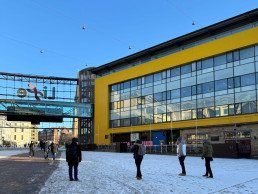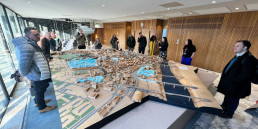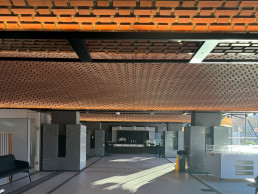Howay and beyond: A trip to Newcastle
One of the joys of being part of the LDN Collective is the opportunity to explore cities and places with passionate people and varied perspectives. This winter we took on Newcastle, where an eclectic mix of architects, video-makers, social and well-being specialists, urban designers and others, were led by LDN Collective CEO Max Farrell on a circular walking tour around the city, capturing many of the city’s interesting masterplanning and architectural projects.

““Last week the LDN Collective had an incredible study trip to one of my favourite cities, Newcastle upon Tyne. It’s a very special place, not just because of the warmth of its people, but also the magnificent architecture with probably the finest street in the UK and the most iconic bridge. I believe Newcastle is about to experience an urban renaissance, with newly devolved powers and the first ever Mayor to be elected in May, significant funds through levelling up and HS2 redistribution, as well as the richest football club in the world and the wider impact that investment will have. For me, the values that characterise the people are humility, hospitality, civic pride and an unbeatable sense of humour. All of which were there in abundance.”
Max Farrell, CEO of LDN Collective
The Tour
Starting at the iconic Millenium Bridge on the River Tyne, we walked along the quayside, which was arguably one of Terry Farrells most important masterplan projects. What seemed radical at the time, was his ambition to open up the once industrial waterfront to the public, connecting the river to the city centre. This required a sensitive approach to historic buildings, carefully blending new and old architecture.

Our journey then led to the Stephenson Quarter, an area named after George Stephenson, the “Father of Railways”. We visited the heritage asset and listed Boiler Shop, a previous locomotive workshop, now with a new life hosting markets, concerts and exhibitions. Our next stop was the Centre for Life – a Life Science centre and also another well-known Terry Farrell Design, framing the city and forming a physical gateway to the previously inaccessible backlands.



Next stop was Helix, where Jenny Hartley, Director at Invest Newcastle, led our tour group around the new mixed-use development, bringing together business, leisure and residential. Each building has a unique design and personality of its own, which in time should nestle within the community as the landscape matures.
We then met with Louise Sloan, Assistant Director for Planning and Pamela Holmes, Principal Engineer at one of my favourite buildings, the grade II* listed Civic Centre, designed by George Kenyon for Newcastle City Council in 1967. Here we learnt about the wider ambitions for Newcastle, alongside more practical wants, like the funding required for repairs to the Tyne Bridge in time for its 100th Anniversary.



Our journey concluded at the Farrell Centre; an urban room, exhibition space and venue for debate on the future of planning and architecture. Socio-economic expert Tim Ashwin presented his recent research and analysis on Newcastle, which then flowed into a broader presentation about the LDN Collective and our specialists within the team.

Newcastle has clearly been, and continues to be, a forward-thinking city; leading the way delivering iconic modernist architecture. The abundance of warm sandstone, found on its curving city streets, gives it a unique charm, which in the most part has been sensitively blended with new buildings. During our trip we saw exciting new structures and interesting forms with contemporary ideas, but I felt these could be offset and enhanced with a prioritisation of landscape and planting, softening the hard surfaces, increasing wildlife and in time, rooting the newer developments in place. As Architects and Landscape Architects we often see projects fall short in this area, and sadly, Newcastle is no different, suffering the same fate. What is exciting in the case of Newcastle is that the City Council recognise the need for urban greening strategies. They are proactively looking for ways to develop these ideas, aligned with local community engagement, as they wish to think more holistically about landscape and well-being, alongside the practical wants and needs of the community. More power to them!
